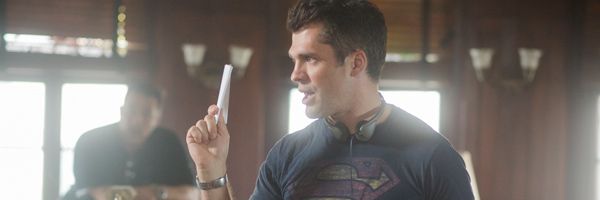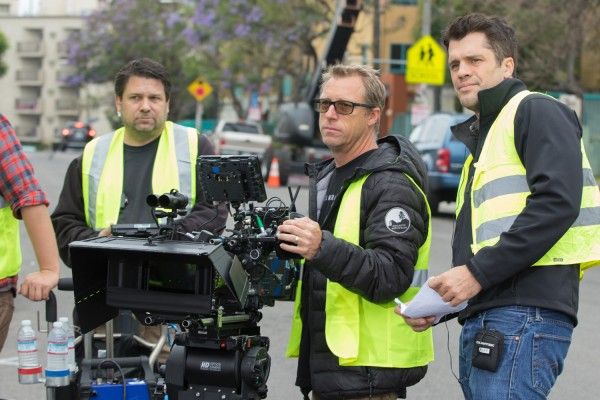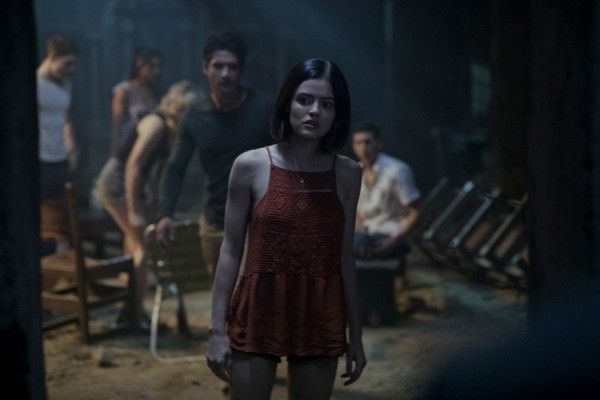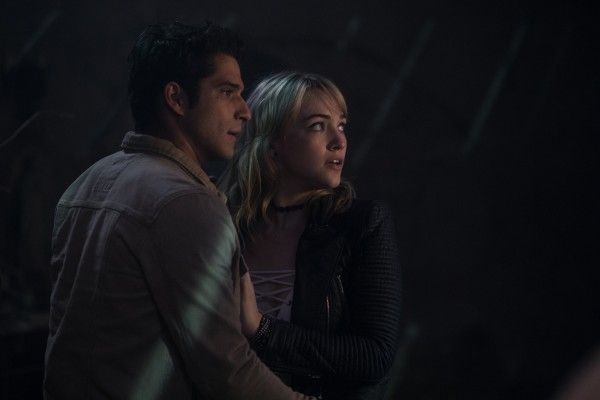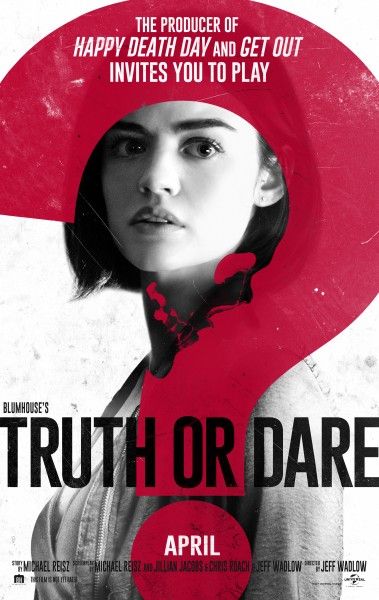Directed by Jeff Wadlow and produced by Jason Blum, the supernatural thriller Blumhouse’s Truth or Dare follows a tightly knit group of friends – Olivia (Lucy Hale), Lucas (Tyler Posey), Markie (Violett Beane), Brad (Hayden Szeto), Penelope (Sophia Ali) and Tyson (Nolan Gerard Funk) – on a trip to Mexico for their last undergraduate getaway, before they all go their separate ways. While there, they play what they think is a harmless game of Truth or Dare, but the game follows them home and forces them to keep playing, leading them to reveal truths that could turn their worlds upside down and carry out life-threatening dares, or they’ll suffer the consequences.
At the film’s Los Angeles press day, Collider got the opportunity to sit down with filmmaker Jeff Wadlow to chat 1-on-1 about what he likes about the Blumhouse model of filmmaking, maximizing all of their resources for the screen, getting to go back and add in some little details, balancing the tone, that creepy possessed face, and the film’s polarizing ending. He also talked about his take on Bloodshot, what his X-Force movie would have been about and why it ultimately didn’t get made, and what he had planned for a Masters of the Universe movie.
Collider: I had no idea what to expect from this movie, and I had a lot of fun with it. There are a lot of clever twists in this and everyone seemed pretty surprised with the ending.
JEFF WADLOW: (SPOILER TALK) It’s funny, when we tested the movie, the most liked scene was the ending, and the least liked scene was the ending. It’s so polarizing. If you think about it, it’s not like she’s dooming people. As long as everyone tells the truth and they do the thing that they’re scared of doing, they’re gonna be fine. We should all live our lives that way.
Did you have to think a lot about the ending, or was is always that ending?
WADLOW: We spent a lot of time thinking about how we got there, but very early on, I knew what I wanted the final moment of the film to be. I just knew that, on a very basic level, as a storyteller. I was like, “That has to be the end of the film.” John Irving, the novelist who wrote The World According to Garp and A Prayer for Owen Meany, wrote this book called A Widow for One Year, and the opening and the final line of the book are the same. I always thought that was a really powerful idea because, in storytelling, often the beginning is the end, but everything is different, and you realize that everything is different because you’re seeing the same thing, but it’s through a totally different filter, since you’ve gone through this journey. So, I love that idea of having the first line also be the same as the last line of a film. (END SPOILER TALK)
What did you like about working under the Blumhouse model of low budget with a fast shooting schedule?
WADLOW: In a weird way, it’s pretty much the way that I make all my films, which is that I always try to maximize the resources. I’d say that, with all pf my films, if I may be a little immodest, whether you like them or not, they all look like they cost more than they did, and that’s what Jason [Blum] does. While I had significantly less money on this movie than my last movie, in many ways, I was just doing the same thing again, which was going, “How do I make this look bigger than it is?”
Were there any particular challenges in that, especially with all of the stunt sequences?
WADLOW: You mean, was there anything that was not a challenge? That’s probably a more appropriate question. No, it was all incredibly difficult. With that roof sequence, I was told by many people who had worked on a lot of Jason’s films, that nothing that complex had ever been attempted before. It’s a long sequence, and it was super dangerous. We were really on a roof, 30 feet in the air, with the real actors and movie cameras. It was very tricky. There were cars and gates being knocked down. It was quite a thing to bite off, but we had a great team. We just planned every detail and maximized our resources.
Were there any dares that you couldn’t do for time or budget, or did you find a way to do what you wanted to do?
WADLOW: Pretty much anything that I couldn’t do, I came up with what I feel was a better choice. I like constraints. When you’re in a box, the only way out is up. I have no real regrets. There were some establishing shots and some little detail shots that I had to cut because we were moving so quickly, but fortunately, Universal loved the movie, so they gave me a little bit of money to go back and get that stuff. I could have finished the movie without it, but don’t tell them that. Those are the moments that just make the movie feel bigger, like the shots of them walking up to the mission. That wasn’t in my first cut because I just didn’t have the time or the money to shoot that stuff, but once they knew the movie was gonna get released wide, they gave me a little more money to go back and get some things.
It definitely adds to the atmosphere.
WADLOW: Yeah, and the scope.
What can you say about your take on Bloodshot?
WADLOW: Wow, I wrote that movie, a long time ago. I wrote that on spec, and Sony loved it and bought it. I had a revisionist take on the character. I hunted down who had the rights because I liked the comic in the ‘90s. They actually ended up relaunching the comic using a lot of the ideas from my script, so there’s a comic out there, even though the movie hasn’t been made yet. I wrote the script in 2010 or 2011, and in the recent comic, they used a bunch of the ideas from the script. I don’t want to ruin it for you, but the big idea that I brought to it was this notion that the ultimate weapon is not a machine, it’s a man. If you look at why Russia lost the conflict in Afghanistan, or why the British were defeated by the Zulu, it’s because technology often doesn’t determine the winner of an outcome, but it’s the will to win that determines it. So, I thought it would be interesting to make a Robocop meets Total Recall movie, where there was an attempt to harness that will.
That does sound like a very interesting take on the material.
WADLOW: Yeah.
How far did you also get with your X-Force movie?
WADLOW: I wrote a draft and they really liked it. They just reached a critical moment, where they were deciding whether they were going to make Deadpool or X-Force. I’ve always loved Deadpool and I tried to rehabilitate him in my X-Force movie because, like the rest of the fans, I felt like they totally screwed it up in X-Men: Origins. I had actually been talking to Ryan Reynolds about playing him in my X-Force movie, but my X-Force movie was much more focused on Cable and the New Mutants becoming this paramilitary unit. So, Fox was trying to decide whether they going to do the Deadpool solo movie or my X-Force movie. Fortunately, they picked the Deadpool solo movie because it’s great. Fortunately for the world, I should say, but unfortunately for me. But, I have no complaints about the process. I’m a huge fan of Ryan’s and I loved the Deadpool solo movie. I’m super excited for Deadpool 2. It’s a little bit of a bummer, but that’s life in the big leagues. I’ll give you my take on it. When I pitched for it, I said, “If X-Men is about the mutants that get to go to private school, I want to make a movie about the mutants that go to public school. They’re the kids that don’t have a jet swooping down to help them, with Hugh Jackman and Patrick Stewart. What’s it like when you don’t have those guys helping you out and you’re forced to figure out who you are in this world?”
What did you have planned for your Masters of the Universe movie?
WADLOW: You’re going through all of my movies that been made yet, or won’t ever get made! I had a really irreverent take on Masters of the Universe, and the studio, at the time, was very focused on a Game of Thrones/Lord of the Rings take. I love He-Man. I still have all my original figures from the ‘80s. That’s how I got the job. I brought them in and put them on the table and was like, “This is why I’m a director!” I wrote a scene where Prince Adam meets Ram Man and says to him, “So, they call you Ram Man, huh?” And he’s like, “Yeah.” And he goes, “Do you like that name?” And Ram Man goes, “I’m owning it.” So, there was an irreverence to it, but at the time, that just didn’t gel with what they wanted to do. It’s interesting now, with Thor: Ragnarok and Guardians of the Galaxy. I think that’s sort of what I was trying to do, but either I was too early or they just never saw it that way. That’s the weird thing about making movies in the studio system. You can have a take and a real point of view, but if it doesn’t line up with the point of view of the people who are writing the checks, it doesn’t matter. That’s why working with Jason [Blum] has been so fantastic. He’s changing the way that movies are made. He’s basically saying, “As long as we keep the budget down, it doesn’t matter what I think. I want you to do what you think is best.”
How tricky is it to balance the tone of a movie like Truth or Dare, where you have death scenes mixed with humor?
WADLOW: It’s not really that tricky. It’s just who I am, as a filmmaker. I also have a great team. I have a fantastic editor. I have great writers that I worked with, that helped me write the script. And I have a great cast. Some of my favorite moments in the movie, that I think are the funniest ones, came up on the set, as improvs. Every movie I make, no matter the genre, will always have levity to it because that’s just the kind of person I am and the kind of stories I want to tell. One of the filmmakers I respect the most, who I aspire to have a career like, is Richard Donner because he’s not defined by one genre. If you look at his resume, he worked in all different genres, like horror, action, comedy and adventure, but all of his films do have a humanity, and a levity to them. I think that’s what real life is like.
The image of the possessed faces will haunt me for awhile.
WADLOW: Good! Mission accomplished!
Just how creepy did you want that to be?
WADLOW: I knew that was going to be our iconic visual, so I shot a camera test, and I tried a bunch of different things and worked with the actors on set. A lot of it is performance. My take on visual effects is to only use them to augment or supplement, so I wanted to create that, as a performance, and then use visual effects just to heighten it a little bit. I don’t like Snap Chat filters. They freak me out a little bit. I find it really disturbing, when you change the anatomy of someone’s face. So, part of the idea came from that and part of the idea came from the fact that I’ve always drawn this evil joker smile when I doodle. We showed the movie to an audience. I was talking to Jason [Blum] and we were both happy the movie had played well and I was smiling, and some woman walked out of the screening and stopped and said, “Oh, it’s your smile! You’ve got the evil smile!” So, I guess it looks like me, a little bit.
Truth or Dare opens in theaters on April 13th.

